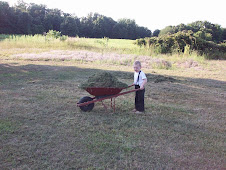
We recently had three great snow days on the farm. More than anything, these days were the silver lining in an otherwise cloudy situation. For two days of the week, I didn’t have enough gas in the car to make the 45 mile drive to my internship in Holland. On the third snow day, the weather was so bad that my supervisor instructed me not to make the drive. So, I lost valuable internship hours and was unable to spend valuable time with clients. Because of the circumstances, it was quite embarrassing.
However, since Jenn was home all three days, and we home school the three youngest children, we were together as a family with three days of unscheduled opportunity. So what happens on a farm during snow days? Well, since we have plenty of food in the house, we didn’t need to shopping or anything like that so we were able to stay home and enjoy the snow. Of course, we had to feed the laying hens and the eight barn cats, but other than those chores, we were able to build snowmen, make full family dinners, do a lot of reading to each other, clean our bedroom, write content for blogs, create art, engage in Bible study, shovel snow together, rescue chickens caught in the snow, feed suet to the winter birds, listen to a music by diverse bands like The Crossing, Talking Heads, and Mudhoney and Motorhead, Taylor Swift, and Parliament.
Snow days are a good time to take naps, and tell stories about infamous blizzards of the past. All of our children were born during winter, so we had snow stories for each birth of the youngest three children. We remember broken arms caused by huge icicles, sledding accidents caused by huge trees, and hockey game cancellations caused by huge storms.
A great thing about blizzards, however, is something rarely talked about on our farm or by others, for that matter. The great things are that we are in a warm place with food, heat, hot water, transportation, and most of all, each other. That is a blessing that many people don’t share. That’s why giving, especially the sharing of time, can be such a blessing to others.
However, since Jenn was home all three days, and we home school the three youngest children, we were together as a family with three days of unscheduled opportunity. So what happens on a farm during snow days? Well, since we have plenty of food in the house, we didn’t need to shopping or anything like that so we were able to stay home and enjoy the snow. Of course, we had to feed the laying hens and the eight barn cats, but other than those chores, we were able to build snowmen, make full family dinners, do a lot of reading to each other, clean our bedroom, write content for blogs, create art, engage in Bible study, shovel snow together, rescue chickens caught in the snow, feed suet to the winter birds, listen to a music by diverse bands like The Crossing, Talking Heads, and Mudhoney and Motorhead, Taylor Swift, and Parliament.
Snow days are a good time to take naps, and tell stories about infamous blizzards of the past. All of our children were born during winter, so we had snow stories for each birth of the youngest three children. We remember broken arms caused by huge icicles, sledding accidents caused by huge trees, and hockey game cancellations caused by huge storms.
A great thing about blizzards, however, is something rarely talked about on our farm or by others, for that matter. The great things are that we are in a warm place with food, heat, hot water, transportation, and most of all, each other. That is a blessing that many people don’t share. That’s why giving, especially the sharing of time, can be such a blessing to others.







